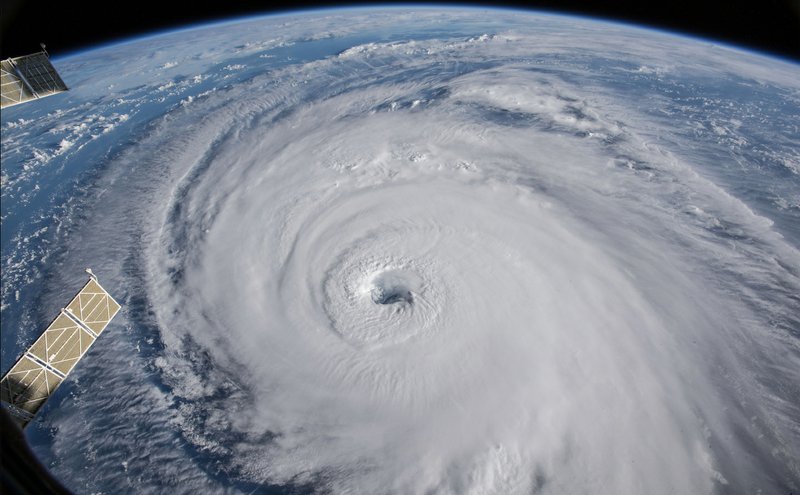Some of us are likely hyperaware of hurricanes right now. During an occasional lull in the coverage of Dorian, I wondered about who decides on hurricane names.
"Their parents?" my boyfriend guessed.
He was off by a little.
I went to the National Oceanic and Atmospheric Administration to learn more. The idea to give human names to tropical storms began in the 1950s.
Before this, the latitude and longitude coordinates of where the storm started would be its name. I'm sure that wasn't confusing at all. And for a while, in the Caribbean Islands, the storm would be named after whichever saint's day it was when the storm hit. A Category 3 storm in 1876 was called the San Felipe hurricane. On the same day in 1928, San Felipe II came along as a Category 5. I think it should have been San Felipe: The Sequel. Or San Felipe Returns.
So, in the 20th century, the weather authorities decided that names would help people keep the storms straight.
A mightier group than NOAA is the World Meteorological Organization. The international organization, a part of the United Nations, offers vast expertise and services on weather, climate, hydrology and geophysical sciences. Plus, it names hurricanes. The organization, in Geneva, has settled on a list of six rotating sets of names. The available names used this year are likely to reappear in 2025.
At first, all of the storms had women's names.
But enough people thought that having all the storms named for women was sexist, so men's names were added to the list in the 1970s. Spanish and French names were added, too. Maybe some Anglophiles protested.
The namers had a little trouble when they got to the end of the alphabet. They couldn't find six names beginning with x, y or z. So Xina, York and Zelda trade off with Xavier, Yolanda and Zeke in the Pacific ocean. In the Atlantic, X, Y and Z names aren't used. Even in the worst years, the Atlantic has about a dozen storms. But when there are more than 21 named storms, Greek letters are applied.
When hurricanes are particularly horrific, the World Meteorological Organization retires that name from the list.
Not just any storm gets a designation. Once a tropical depression has winds of at least 39 mph, it becomes a tropical storm and receives its name. When winds reach 74 mph, it becomes a hurricane with the same name.
The names we typically hear about are for the North Pacific and North Atlantic storms. Each of the seven ocean basins has sets of names. In the Southwest Indian basin, where hurricanes are called cyclones, the names include Aivu, Cilida and Jobo. In the Northwest Pacific basin, where hurricanes are called typhoons, the names include Fitow, Lekima and Wutip.
You never know what stories will come out of these names.
In 1998, my friends Madeline and Mitch were married in October. That month, Hurricane Madeline roiled the Pacific and reached Category 1. Soon after Madeline faded, Hurricane Mitch started a deadly sweep in the Atlantic and reached Category 5. Mitch caused such destruction that the name was retired from the lineup. My Madeline and Mitch are still together, but the two hurricanes will never again be together on the world stage.
The people who write headlines and other text for the next day's newspaper have to be careful with the words they use, primarily because of the time gap that occurs and the volatility of storms. In 1938, The Springfield Union of Massachusetts predicted that Sept. 20 would see "Rain today and possibly tomorrow." Before the Great Hurricane of 1938 (I guess in those days they used just adjectives and years) left the area, the winds and rain caused the deaths of almost 700 people.
So, many editors are careful about not being too comical or offhand. Here are some results over the years:
2004: "Frances, Jeanne were like evil twins"
2011: "Mean Irene"
2012: "Stormin' Sandy"
2005: "The Drama of Dennis"
Sure, ordinary people want to name hurricanes, too. Lots of people email the National Hurricane Center with suggestions, but those likely never make their way to wherever the World Meteorological Organization happens to meet.
Some of the suggestions have been entertaining. One person wanted storms named after terrible people such as Adolf Hitler. One person suggested the names of less popular vegetables, such as rutabaga (I would fear Hurricane Cauliflower).
A few other likely not-serious suggestions: Swirly McWindface, Smhurricane, Voldemort and Mother-in-Law. You can find many more on Twitter under #RejectedNamesForHurricanes. My favorite, though, was "Jake From State Farm."
The hurricane naming process even has made its way into scientific studies. A 2014 study concluded that more people are killed in hurricanes that have women's names because people don't take them seriously. It concluded that this was caused by a "hazardous form of implicit sexism."
A study two years later debunked most of the research parameters and data of the 2014 study.
Sources include NOAA, Live Science, Science Direct, World Meteorological Organization, Geology.com, The Weather Service, Historic Newspaper Archive, Romper, The Washington Post, Hunter College. Reach Bernadette at
Style on 09/16/2019

